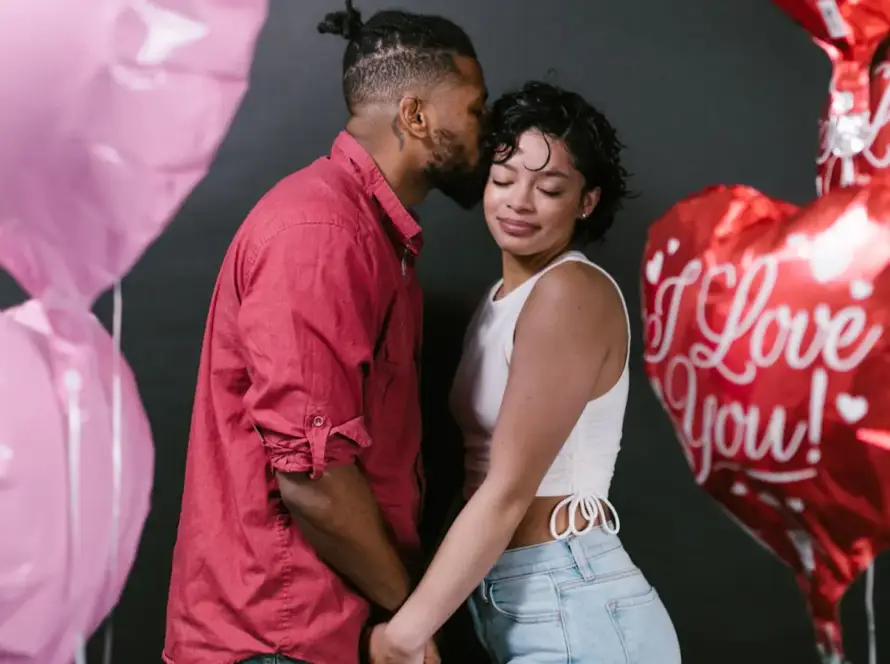
Exhibitionism is not just about streaking at football games.
It’s about the thrill of being seen.
Some people love the spotlight.
Others prefer to exist in the shadows like a stylish ninja.
But when exhibitionism creeps into relationships, things can get messy.
One partner might enjoy flaunting their assets, while the other wishes they would tone it down.
Some couples embrace the attention together.
Others find it a constant source of tension.
If exhibitionism is part of the mix, figuring out where the line is drawn can make or break the relationship.
The Secret Sauce of Attraction: Why We Love to Be Seen
Humans love attention.
Even the most introverted souls appreciate a well-timed compliment.
Exhibitionism taps into this desire to be noticed, admired, and maybe even envied.
It’s why people dress up for date night, post vacation selfies, and strut like peacocks when their crush is watching.
Some people are natural-born exhibitionists.
They walk into a room and demand attention without saying a word.
Others get a rush from wearing something daring or dancing a little too boldly in public.
Exhibitionism can be a harmless confidence boost.
But when it starts becoming a lifestyle, it can clash with a partner who doesn’t share the same enthusiasm.
At its core, exhibitionism isn’t just about showing off, it’s about validation.
Everyone wants to feel attractive, desirable, and interesting.
Some get that validation from deep conversations and emotional intimacy.
Others get it from an appreciative audience.
Whether that audience is a crowded bar, social media followers, or a few strangers giving side-eye at the grocery store depends on the person.
Interestingly, studies suggest that attention, even from strangers, triggers dopamine, the brain’s pleasure chemical.
That’s why some people feel energized after being noticed.
It’s also why others feel drained by too much public attention.
Some thrive in the spotlight, while others would rather melt into the floor than be the center of focus.
It’s not just a personality difference… it’s brain chemistry.
Exhibitionism also plays into a subtle power dynamic.
There’s something intoxicating about knowing people are looking but only giving your affection to one person.
It creates a sense of control.
The person in the spotlight holds the power, deciding who gets their attention and who doesn’t.
This can be harmless fun in a relationship, like making your partner jealous in a playful way.
But it can also be a source of conflict if one partner starts feeling like they’re competing for attention.
Cultural influences also shape how exhibitionism plays out in relationships.
In some cultures, showing off is celebrated.
In others, modesty is expected.
This means that what feels normal to one person might feel over-the-top to another.
A couple from different cultural backgrounds may find themselves clashing over what level of exhibitionism is acceptable.
The bottom line?
Exhibitionism isn’t just about being seen, it’s about how being seen makes someone feel.
For some, it’s empowering.
For others, it’s overwhelming.
And when two partners experience it differently, things can get complicated.
When Exhibitionism Enters the Relationship Chat
Attraction thrives on excitement.
A little exhibitionism keeps things spicy.
The problem?
Not everyone defines “spicy” the same way.
A woman might love dressing up and getting compliments.
Her partner might feel uncomfortable when too many people start looking.
A guy might enjoy flirting with the camera for social media.
His girlfriend might hate the idea of him putting himself on display.
Some people see exhibitionism as playful fun.
Others see it as unnecessary attention-seeking.
The challenge in relationships is figuring out which category it falls into.
Is it about confidence, self-expression, or something deeper?
For some couples, exhibitionism is a shared thrill.
They love dressing up, showing off, and soaking in the attention together.
It becomes part of their dynamic, an unspoken game where they both enjoy knowing that others are looking, but at the end of the day, they belong to each other.
Other couples struggle with mismatched comfort levels.
One person might think showing a little skin or being the center of attention is harmless.
The other might see it as disrespectful.
These mismatches can cause silent resentment or loud arguments.
Either way, they need to be addressed before they spiral into full-blown relationship drama.
It also depends on context.
What feels playful in one situation might feel inappropriate in another.
A sexy dress on date night?
No problem.
The same dress at a formal family gathering?
Maybe a different story.
A flirty joke with a friend might be harmless in private but feel embarrassing if it’s made in front of others.
The “where” and “when” of exhibitionism can be just as important as the “why.”
Exhibitionism can also shift over time.
A partner who once loved being the center of attention might grow out of it.
Someone who was once shy might suddenly embrace their inner show-off.
Life events, aging, and evolving self-confidence all play a role in how comfortable people feel with being seen.
What worked in the beginning of a relationship might not work later.
That’s why ongoing communication is key.
If exhibitionism is starting to create tension, it’s not always about the behavior itself.
It’s about how each partner feels about it.
Does one person feel unseen or insecure?
Does the other feel stifled or judged?
The answers to those questions are often more important than whether or not someone likes to be in the spotlight.
At the end of the day, exhibitionism in a relationship isn’t about right or wrong.
It’s about making sure both partners feel valued and respected.
Whether that means embracing a little extra attention or setting clear boundaries depends on the couple.
Either way, the conversation needs to happen, before it turns into a full-on showdown of differing comfort levels.

The Fine Line Between Confidence and Attention-Seeking
Confidence is attractive.
Desperation for attention?
Not so much.
There’s a big difference between someone who enjoys being noticed and someone who needs to be noticed.
Confidence is about feeling good in your own skin.
Attention-seeking is about needing external validation to feel good at all.
One is self-assured, the other is exhausting.
Exhibitionism, when rooted in confidence, can be incredibly sexy.
It shows a person who knows their worth and isn’t afraid to express themselves.
A confident partner might wear bold outfits, post a striking selfie, or command a room with their presence, but they’re not doing it because they need the applause.
They’re doing it because they feel good about themselves, and that energy naturally draws people in.
On the other hand, attention-seeking behavior often comes from insecurity.
If someone constantly needs validation from outside their relationship, it might be a sign of deeper issues.
Some people post suggestive pictures or flirt openly, not because they’re just having fun, but because they crave reassurance that they’re still attractive, desirable, or valuable.
This becomes a problem when it starts affecting their partner’s sense of trust and security.
The tricky part is that confidence and attention-seeking can look similar on the surface.
A person posting a sultry selfie might be doing it because they feel great about themselves.
Or they might be doing it to fish for compliments because they’re feeling down.
Someone who enjoys turning heads at a party might be confident and fun-loving.
Or they might be masking deeper insecurities by constantly seeking approval.
The intention behind the behavior matters more than the behavior itself.
This is where exhibitionism can get complicated in relationships.
If one partner is genuinely confident and loves expressing themselves, their exhibitionism can add excitement to the relationship.
It can make them magnetic and intriguing.
But if it starts crossing into attention-seeking territory, their partner may start feeling overlooked, disrespected, or even humiliated.
The key to understanding the difference is to ask: Would this person still do this if nobody reacted?
A confident person wears the outfit, posts the picture, or commands the room because it makes them feel good, not because they’re hoping for a specific reaction.
An attention-seeker, on the other hand, needs the reaction.
Without it, they might feel invisible or unworthy.
Another way to tell the difference is how the person reacts when they don’t get attention.
A confident person shrugs it off.
An attention-seeker might spiral, get irritated, or double down on trying to be noticed.
If someone in a relationship constantly pushes boundaries, flirts excessively, or needs outside approval more than they need their partner’s, it’s a red flag.
Healthy exhibitionism adds fun, confidence, and playfulness to a relationship.
Unchecked attention-seeking drains it.
If exhibitionism is making one partner feel insecure rather than excited, it’s time to figure out whether it’s coming from a place of confidence, or something more complicated.
Social Media: The Exhibitionist’s Playground
Exhibitionism isn’t just about what happens in public.
It’s also about what happens online.
Social media has turned exhibitionism into an everyday experience.
It’s no longer just about wearing a daring outfit to a party or turning heads on a night out.
Now, it’s about curated Instagram grids, thirst traps, and TikTok dances that get millions of views.
A single post can bring more attention than an entire night at the club.
For some, social media is just a fun way to share their life.
For others, it’s an all-consuming need to be seen, liked, and validated.
The line between casual posting and full-blown exhibitionism gets blurry.
Is it confidence?
Is it attention-seeking?
Or is it just harmless fun?
That depends on how both partners feel about it.
Some couples thrive on social media exhibitionism.
They post cute couple photos, share flirty videos, and enjoy the attention together.
For them, social media is just another way to express attraction and excitement.
But for others, it creates conflict.
If one partner constantly posts seductive selfies or engages with flirty comments from strangers, the other might start feeling uncomfortable.
The trouble starts when social media attention starts feeling more important than real-life connection.
If one person is more focused on racking up likes than engaging with their partner, resentment builds.
It’s even worse when validation from strangers starts feeling more exciting than affection from the person they’re in a relationship with.
Then there’s the issue of boundaries.
What’s okay to post?
What crosses the line?
Some people see nothing wrong with showing a little skin or sharing personal details online.
Others feel it should be kept private.
If one person is constantly pushing the limit while the other is uncomfortable, it can lead to arguments.
Even something as simple as responding to comments can be a source of tension.
Some partners see flirty DMs and heart-eye emojis as harmless.
Others see them as disrespectful.
If social media interactions start feeling like emotional cheating, exhibitionism can quickly turn from playful to painful.
The biggest problem with social media-driven exhibitionism is that it never really stops.
In real life, attention is temporary.
A glance, a compliment, a passing moment, then it’s over.
But online, validation is always available.
The thrill of being seen can become addictive, leading some people to chase attention at the expense of their relationship.
Couples who navigate this successfully set clear expectations.
What’s okay to post?
What’s not?
How much is too much?
And most importantly: if social media validation ever starts feeling more important than real-life intimacy, it’s time for a serious conversation.
Exhibitionism online isn’t necessarily bad.
But when it starts to replace genuine connection, that’s when the real trouble begins.
When One Partner Loves Exhibitionism and the Other Loathes It
Not every couple is on the same page when it comes to exhibitionism.
One person might love being noticed, while the other would rather blend into the wallpaper.
That’s where things get complicated.
For the exhibitionist, showing off might feel completely natural.
They thrive on the thrill of turning heads, getting compliments, and feeling seen.
It’s not necessarily about attracting other people, it’s about self-expression, confidence, or simply having fun.
They might not even realize that their partner sees their behavior differently.
For the non-exhibitionist, it can feel like unwanted exposure.
They might worry about how others perceive the attention-seeking behavior.
Is it flirty?
Is it disrespectful?
And is it making them look like a fool?
Even if the exhibitionist has no bad intentions, their partner might still feel embarrassed, uncomfortable, or even disrespected.
This isn’t just about jealousy.
It’s about personal values and comfort levels.
Some people believe attention should come from within the relationship, not from outside sources.
Others don’t see a problem with a little extra admiration from the world.
If one person believes exhibitionism is harmless fun and the other sees it as a betrayal, tension is inevitable.
The challenge is that neither person is necessarily wrong.
The exhibitionist isn’t evil for loving attention.
The non-exhibitionist isn’t controlling for wanting more privacy.
But without compromise, both partners end up feeling misunderstood.
Some couples try to ignore the issue, but that rarely works.
One partner starts feeling stifled, while the other feels disrespected.
Arguments start brewing.
Resentment builds.
And suddenly, what was once a small difference turns into a full-blown relationship crisis.
The solution?
Open, honest conversations.
The exhibitionist needs to understand their partner’s feelings without immediately feeling attacked.
The non-exhibitionist needs to express their discomfort without sounding like they’re policing their partner.
Both people should ask themselves: What is the real issue here?
For the exhibitionist, is it about personal confidence, or is it a need for outside validation?
If it’s confidence, great, there’s probably a way to express it while keeping their partner comfortable.
But if it’s about filling an emotional void, that’s a deeper issue that won’t be solved with more likes and compliments.
For the non-exhibitionist, is the discomfort about insecurity, or is it about genuine concern for the relationship’s boundaries?
If it’s insecurity, they might need reassurance.
If it’s about relationship values, they need to discuss clear expectations with their partner.
Compromise is key.
Maybe the exhibitionist tones it down in certain situations.
Maybe the non-exhibitionist becomes more open-minded about what “harmless fun” actually means.
What matters most is that neither partner feels forced into something that makes them deeply unhappy.
A little mismatch in exhibitionism won’t destroy a relationship.
But a refusal to communicate about it?
That absolutely will.

The Jealousy Factor: When Exhibitionism Feels Like Betrayal
Not everyone is okay with their partner soaking up attention.
Jealousy creeps in when exhibitionism starts feeling like a performance for the world rather than a private expression of confidence.
If a partner enjoys being admired, it can be harmless fun, or it can make the other person feel like they’re being put in competition with strangers.
When admiration from others starts feeling more exciting than validation from the relationship, it raises serious questions.
The tricky thing about jealousy is that it doesn’t always come from insecurity.
Sometimes, it comes from feeling disrespected.
If a partner constantly seeks attention in ways that make the other uncomfortable, it’s not just a personal issue, it’s a relationship issue.
Seeing a partner bask in the admiration of others can make someone feel like their affection isn’t enough.
There’s also the issue of intent.
If someone naturally attracts attention without trying, that’s one thing.
But if they seek attention, posting suggestive photos, wearing revealing outfits for the sake of being noticed, or flirting just for reactions, it can feel like a betrayal.
A partner might wonder: Are they doing this for themselves, or are they doing this for someone else?
Jealousy also escalates when exhibitionism crosses into public interactions.
It’s one thing to enjoy looking good, it’s another to encourage or entertain outside attention.
Some people don’t mind their partner turning heads, but they do mind when their partner actively engages with admirers.
Social media makes this even more complicated.
If one partner is posting thirst traps, responding to flirty comments, or constantly engaging with admirers, the other might feel invisible.
It’s easy to dismiss online interactions as “just likes and comments,” but in reality, they can affect a relationship just as much as in-person interactions.
The digital world has made exhibitionism a 24/7 opportunity, which means jealousy doesn’t just happen in real-life moments, it follows couples into their phones, notifications, and DMs.
Another layer of jealousy comes from social perception.
Some partners don’t just feel uncomfortable with exhibitionism, they worry about how it makes them look.
If someone is in a committed relationship but constantly flaunting themselves for outside attention, it can make their partner feel disrespected, or worse, humiliated.
They might wonder if others are judging them, questioning the seriousness of their relationship, or even assuming their partner is still available.
The real problem with jealousy and exhibitionism isn’t necessarily the act itself, it’s the lack of boundaries.
Some couples can laugh off outside attention, while others feel like it threatens their relationship.
What matters is making sure both partners feel respected.
If jealousy is becoming a problem, it’s time to set clear expectations.
What’s okay?
What isn’t?
Is it just a confidence boost, or is it feeding an unhealthy need for outside approval?
The goal isn’t to control each other, it’s to find a balance where both people feel valued.
At the end of the day, exhibitionism isn’t always a dealbreaker.
But when it starts creating real jealousy, tension, or emotional distance, it’s a sign that something deeper needs to be addressed.
Because if one person in the relationship is constantly chasing outside attention, the real question becomes: Who are they really trying to impress?
How to Make Exhibitionism Work for Both of You
Exhibitionism doesn’t have to ruin a relationship.
But it absolutely can if there’s no communication.
The key is to figure out what’s fun, what’s respectful, and what crosses the line.
Every couple has different boundaries, and what works for one might not work for another.
Some people love a partner who turns heads.
Others want to be the only person getting their significant other’s attention.
Neither is wrong!
It just depends on what makes both people feel secure.
A good starting point is to ask: What does exhibitionism mean to each partner?
If one person sees it as harmless fun and the other sees it as a betrayal, that gap needs to be bridged.
Maybe the exhibitionist enjoys self-expression, dressing up, or feeling confident in public.
Maybe their partner sees it as unnecessary or even disrespectful.
The goal isn’t to convince each other who’s “right” it’s to understand what makes each person feel valued.
Boundaries need to be clear and specific.
Saying, “Don’t be too attention-seeking” is vague.
What does that actually mean?
Is it about clothing choices?
Social media behavior?
Flirting in public?
Does it bother someone when their partner posts revealing pictures, or are they fine as long as they don’t respond to flirty comments?
The more specific the boundaries, the less likely they are to be misunderstood.
It’s also important to check in on why one partner enjoys exhibitionism.
If it’s about confidence and self-expression, that’s one thing.
But if it’s about needing validation from others, that’s a deeper issue that should be addressed.
A partner shouldn’t feel like they have to compete with the world for attention.
Likewise, the less-exhibitionist partner should ask themselves: Am I uncomfortable because my partner is crossing a line, or because of my own insecurities?
If it’s the latter, they might need more reassurance rather than stricter boundaries.
Feeling possessive or overly jealous isn’t healthy, but neither is dismissing real concerns.
A great way to make exhibitionism work for both partners is to redirect some of that energy into the relationship itself.
Instead of seeking admiration from strangers, can that attention-seeking be funneled toward the partner?
If one person enjoys dressing up and feeling sexy, can they make their partner a bigger part of that experience?
If one person loves showing off on social media, can their partner be included in ways that make them feel special rather than sidelined?
Compromise also plays a huge role.
Maybe the exhibitionist tones it down in certain settings, like around family or at formal events.
Maybe the non-exhibitionist learns to be more accepting in low-stakes situations, like a fun night out or a harmless Instagram post.
Relationships work best when both people feel like their needs are being met without sacrificing too much of themselves.
At the end of the day, exhibitionism isn’t the enemy, disrespect is.
If both partners feel heard, valued, and secure, a little extra attention from the outside world doesn’t have to be a big deal.
But if one person starts feeling ignored, undervalued, or second place to social media likes and strangers’ stares, that’s when problems begin.
The ultimate goal?
Making sure the only validation that truly matters comes from within the relationship itself.
Because no amount of public admiration can ever replace the feeling of being deeply seen and appreciated by the person who matters most.
Conclusion
Exhibitionism itself isn’t the issue, it’s how couples handle it that determines whether it strengthens or weakens their bond.
The key is communication, understanding, and setting clear boundaries so that both partners feel respected.
A little extra attention can be fun, but if it starts creating insecurity or resentment, it’s time for an honest conversation.
That’s where the Better Topics Card Game for Couples comes in.
This fun, replayable game is designed to improve communication, deepen emotional connection, and keep relationships playful.
With repeatable questions that spark meaningful (and sometimes flirty) conversations, it’s the perfect way to understand your partner’s thoughts on exhibitionism, or any other topic that might be causing friction.
Plus, since the questions can be played over and over, it keeps your relationship growing and evolving.
If you want to strengthen your bond, build trust, and bring more fun into your relationship, grab Better Topics and play it with your partner.
It’s an easy way to talk, laugh, and stay connected, because the best kind of attention is the one that comes from each other.










